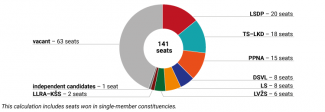Lithuania: following the first round of the parliamentary election, the Social Democrats are well-positioned to assume power
In the parliamentary election held on 13 October, six parties surpassed the 5% electoral threshold. The Social Democratic party (LSDP) emerged as the winning party, securing 19.36% of the vote, which translated into 18 seats. The conservative Homeland Union/Lithuanian Christian Democrats (TS-LKD), which had governed for the past four years, came second with 17.96% of the vote and 17 seats. The populist Dawn of Nemunas party (PPNA), founded in 2024, came third with 14.99% of the vote, earning 14 seats. The opposition Union of Democrats “For Lithuania” (DSVL) secured 9.24% of the vote, giving them eight seats in the Seimas. The Liberals’ Movement, the current coalition partner of the conservatives, secured seven seats with 7.7% of the vote, while the opposition Lithuanian Farmers and Greens Union (LVŽS) captured six seats with 7.02%.
Another coalition partner of the conservatives, the Freedom Party, failed to cross the electoral threshold (4.50%). The same applies to the Electoral Action of Poles in Lithuania – Christian Families Alliance (LLRA–KŠS; AWPL–ZCHR [Polish]), which received 3.89% of the vote. However, it secured two seats in the Seimas through single-member districts, and three of its representatives have advanced to the second round of the election.
In the first round, under a proportional representation system in a single multi-member constituency covering all of Lithuania, 70 out of 141 MPs were elected. Additionally, voters elected representatives to eight of the 71 seats that are chosen in single-member constituencies. This year, successful candidates had to garner more than half of the votes with the minimum turnout of 40% in a specific constituency, or at least 20% of the votes cast by all registered voters in a constituency with a lower turnout. In the second round (on 27 October), two candidates who obtained the best results in the first round will compete in 63 single-member constituencies. In the 13 October election, the turnout was 52.04%, compared to 47.80% in 2020.
Although the Social Democrats’ victory allows them to plan a new centre-left coalition, the results of the second round will determine their coalition partners. Regardless of the future government’s composition, Lithuania’s pro-Western orientation and support for Ukraine will continue.
Commentary
- Although the Social Democrats did not win the election by a landslide, they have a greater chance of forming a stable majority compared to the conservatives. This is due to their stronger coalition-forming potential, having recently aligned with the Democrats led by former PM Saulius Skvernelis, with both parties agreeing to establish a new coalition and pledging not to attack each other in the second round of the election. The Social Democrats are also in a favourable position to form alliances with other potential partners, such as LVŽS and LS, and have enjoyed the support of President Gitanas Nausėda for many months. Nausėda, who is at odds with the conservatives, favours the appointment of LSDP leader Vilija Blinkevičiūtė as prime minister.
- Due to the similar results achieved by the Social Democrats and the conservatives, both parties will continue their efforts to mobilise their electorate. If the conservatives secure a good result in the second round of the election, they could be able to form an alternative majority coalition. In the single-member constituency voting, the LSDP has secured an additional two seats and is positioned to win a further 20 seats, because its candidates led in as many constituencies and now are starting as frontrunners. The TS–LKD has secured one seat in a single-member constituency through the votes cast for the incumbent PM Ingrida Šimonytė. However, the party may win an additional 25 seats in constituencies where its candidate finished first in the recent election round. The fact that the conservatives came second does not signify a decisive defeat, demonstrating that they retain a loyal electorate undeterred by harsh criticism of the government.
- The strong result achieved by the populist PPNA party was not unexpected. The party’s supporters largely consisted of protest voters and the supporters of other anti-establishment parties. Its founder and leader, Remigijus Žemaitaitis, is currently one of Lithuania’s most controversial politicians, known for his conservative worldview and anti-Semitic remarks. He demonstrated his popularity by winning the election in a single-member constituency seat, with three other representatives of his party favoured to win in the second round in their constituencies. Although the Social Democrats have announced that they would not form a coalition with Žemaitaitis, their assertions are not as strong as those expressed by the conservatives, who have called for isolating the PPNA. The party’s rising popularity among the Lithuanian public has raised concerns among Lithuania’s strategic partners, including the US and Germany. Moreover, Žemaitaitis’s anti-Semitic remarks have drawn criticism from the Jewish community in both Lithuania and abroad.
- With its result of 3.89% (down from 4.8% in 2020), the LLRA–KŠS has lost some ground. Lithuanian Poles are increasingly running as candidates on other parties’ electoral lists. Despite this, the party will still be represented in the Seimas, as two of its MPs – Rita Tamašunienė and Jarosław Narkiewicz – won their seats in the first round of the election in the Nemenčinė and Šalčininkai constituencies. Notably, Waldemar Urban, who came first in the Riešė constituency, may secure a third seat, while Edyta Tamašunienė and Czesław Olszewski are also running as candidates placed second in two other single-member constituencies. The party’s leader, Waldemar Tomaszewski, who decided not to run in any constituency in the Vilnius region, suffered a defeat. He was a candidate in Klaipėda, where he primarily relied on votes from the Russian minority, but only placed fifth.
Chart. Division of seats in the Seimas of the Republic of Lithuania following the first round of the parliamentary election

Source: the author’s own analysis based on the election results published by vrk.lt.


